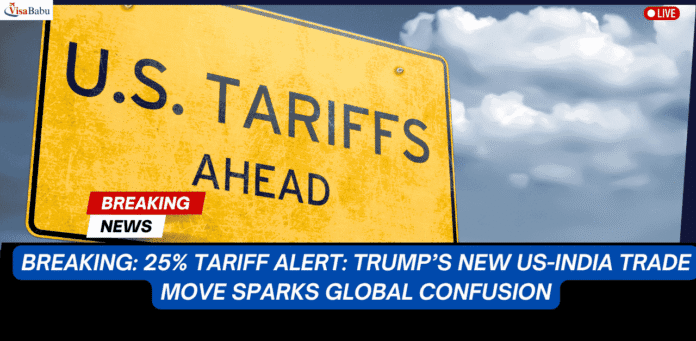Trump’s 25% Tariff on India: Sector Impact, Penalty, and What’s Next (2025 Update)
In a move that caught markets and diplomats by surprise, Trump announced a sweeping 25% tariff on all Indian imports to the US, effective August 1, 2025. This unprecedented tariff will be coupled with an “unspecified penalty” targeting India’s ongoing trade with Russia—particularly related to oil and defense equipment purchases. This sharp turn in US-India relations follows months of stalled trade negotiations and comes just days before the previous tariff suspension was set to expire.
Why Did Trump Impose the 25% Tariff on India in 2025?
Donald Trump’s decision is rooted in ongoing US complaints about high Indian tariffs on American goods, described as “among the highest in the world” and “strenuous and obnoxious non-monetary trade barriers.” On Truth Social, Trump claimed that the US-India business has remained limited due to India’s protective policies.
Additionally, the penalty is a direct response to India’s increased purchases of Russian oil and arms, which the US views as undercutting Western efforts to isolate Russia over the Ukraine war.
What India does with Russia does not matter to me. They may as well go to hell together in their dead economies, as far as I am concerned. We have done very little business with India; their tariffs are too high,” Trump wrote.
Timeline: Trump’s Tariff Actions on India
| Date | Action | Details |
| April 2, 2025 | Initial tariff threat (26%) | Later, suspended for negotiations |
| July 30, 2025 | Official 25% tariff and penalty announced | To be enforced from August 1, 2025 |
| August 25, 2025 | US team to visit India for trade talks | Next round of negotiations scheduled |
Sectors Most at Risk After Trump’s Tariffs Slap
Export-reliant industrial sectors in India, particularly those that used to trigger the growth in the United States, are expected to be severely affected by the new 25 per cent tariff. However, a notable exemption currently shelters smartphones and pharmaceuticals, which together represent over $25 billion in Indian exports to the US.
| Sector | 2024 Export Value (USD bn) | Tariff Impact | Notes |
| Electronics (incl. smartphones) | 14.6 | Low/Exempt | Exempt (as of August, but may change) |
| Pharmaceuticals | 10.5 | Low/Exempt | Exempt (as of August, but may change) |
| Gems & Jewellery | 10+ | High | Severe impact, risks to supply chain |
| Textiles | 8.2 | High | Sensitive to US tariff hikes |
| Auto Components | 3.7 | Medium-High | Potential demand slowdowns |
| Steel & Aluminum | 3.5 | Medium | Price/demand volatility |
| Solar Equipment | 2.6 | High | Growth sector, vulnerable |
Why now? The Diplomatic and Economic Backdrop
- The US and India have staged several rounds of trade negotiations since a high-profile visit to the White House by Indian Prime Minister Narendra Modi in February 2025.
- Although certain victories were recorded (India reduced tariffs on bourbon whiskey and motorcycles), agricultural market entry and restrictions on imports of technology are a bone of contention.
- The step by Trump is primarily interpreted as a demand to hasten a concluding trade deal and to lash out against current Russian transactions. The White House emphasised that the 25 per cent tariff is stronger than that of most other Asian economies: Vietnam (20 per cent), Indonesia (19 per cent), and Japan (15 per cent).
Indian Government and Opposition Response After Trump’s Tariff Slap
Trump’s decision has been termed completely unreasonable by the Indian government, and they are studying the implications before acting. Soon after the announcement, the Commerce Minister Piyush Goyal and the Foreign Minister S. Jaishankar met and discussed future actions.
The move was termed as worthless foreign policy by the opposition leaders, and they demanded a debate in parliament. In the meantime, industries such as gems and jewellery threatened to lose many jobs and increase the price burden on the American consumers.
Market and Macro Impact After Trump’s Tariffs in 2025
- On July 31, 2025, the Sensex fell by more than 500 points after the news.
- The rupee was at a month’s low.
- Analysts estimate that GDP growth in India may be reduced by as much as 0.4 percent if the tariffs are not removed.
How Does This Compare to Recent US Tariffs Globally?
| Country/Region | Tariff Level (%) | Special Penalties | Status |
| India | 25 | Additional for Russia buys | No US deal yet |
| Vietnam | 20 | None | Tariff deal reached |
| Indonesia | 19 | None | Tariff deal reached |
| Japan, the EU, and Korea | 15 | None | Deal reached |
| Brazil | 50 | Political reasons | Unilateral US action |
What’s Next after Trump’s Tariffs?
The next round of US-India trade negotiations is slated for August 25, 2025.
Both exporters, investors, and policymakers will monitor the situation intently because as long as the situation remains stagnant, global supply chains will experience significant malfunctions, yet a breakthrough will ease the situation.
For more updates like this, please visit: visababu.com
Frequently Asked Questions (FAQs)
Q1: What is the Trump 25% tariff on India?
A: President Donald Trump announced a 25% tariff on all Indian imports to the US, effective August 1, 2025, plus an additional penalty related to India’s Russian oil and defence purchases.
Q2: What are the most afflicted Indian export industries?
A: Gems and jewellery, textiles, solar, auto components, and steel/aluminium are most affected. Electronics and pharmaceuticals are currently exempt.
Q3: Why is there an additional penalty besides the tariff?
A: The penalty targets India’s close trade ties with Russia, particularly its purchase of oil and arms—moves seen as undermining US-led sanctions on Russia.
Q4: Will trade negotiations between India and the US continue?
A: Yes, formal talks are scheduled for August 25, 2025, but there is pressure for a rapid breakthrough to avoid long-term export disruptions.
Q5: What is the comparison between the US-India tariff and other countries’ tariffs?
A: The US has settled on lower rates for Vietnam (20%), Indonesia (19%), and Japan/EU/Korea (15%). The 50 percent rate is only higher in Brazil.
Q6: What is each Indian exporter to do now?
A: Many are exploring other markets, front-loading shipments, and lobbying for sector exemptions as government negotiations continue.




